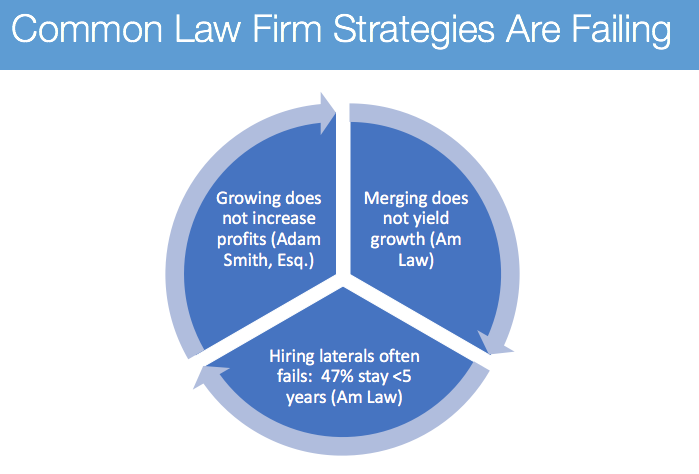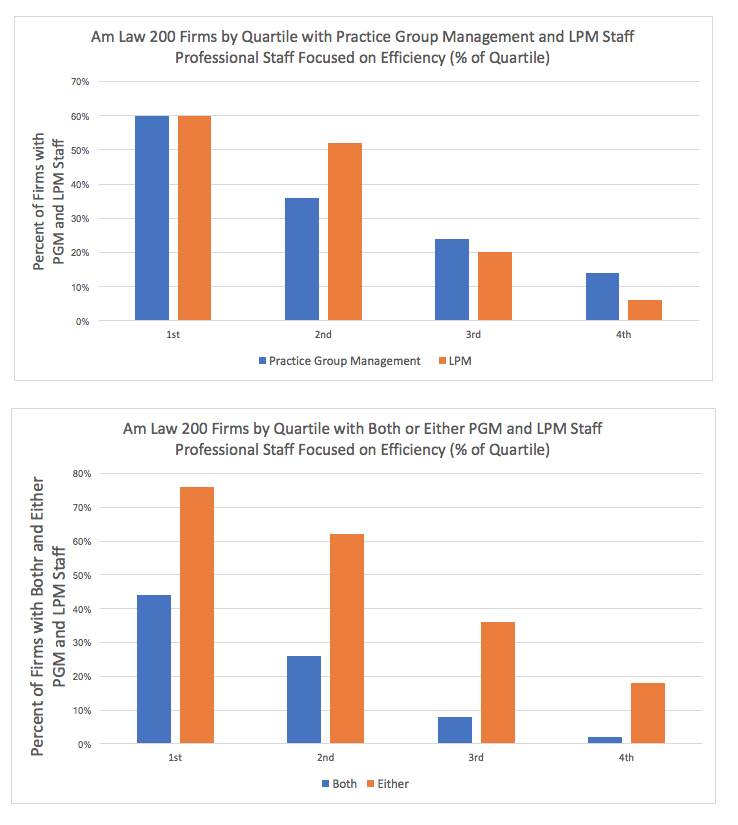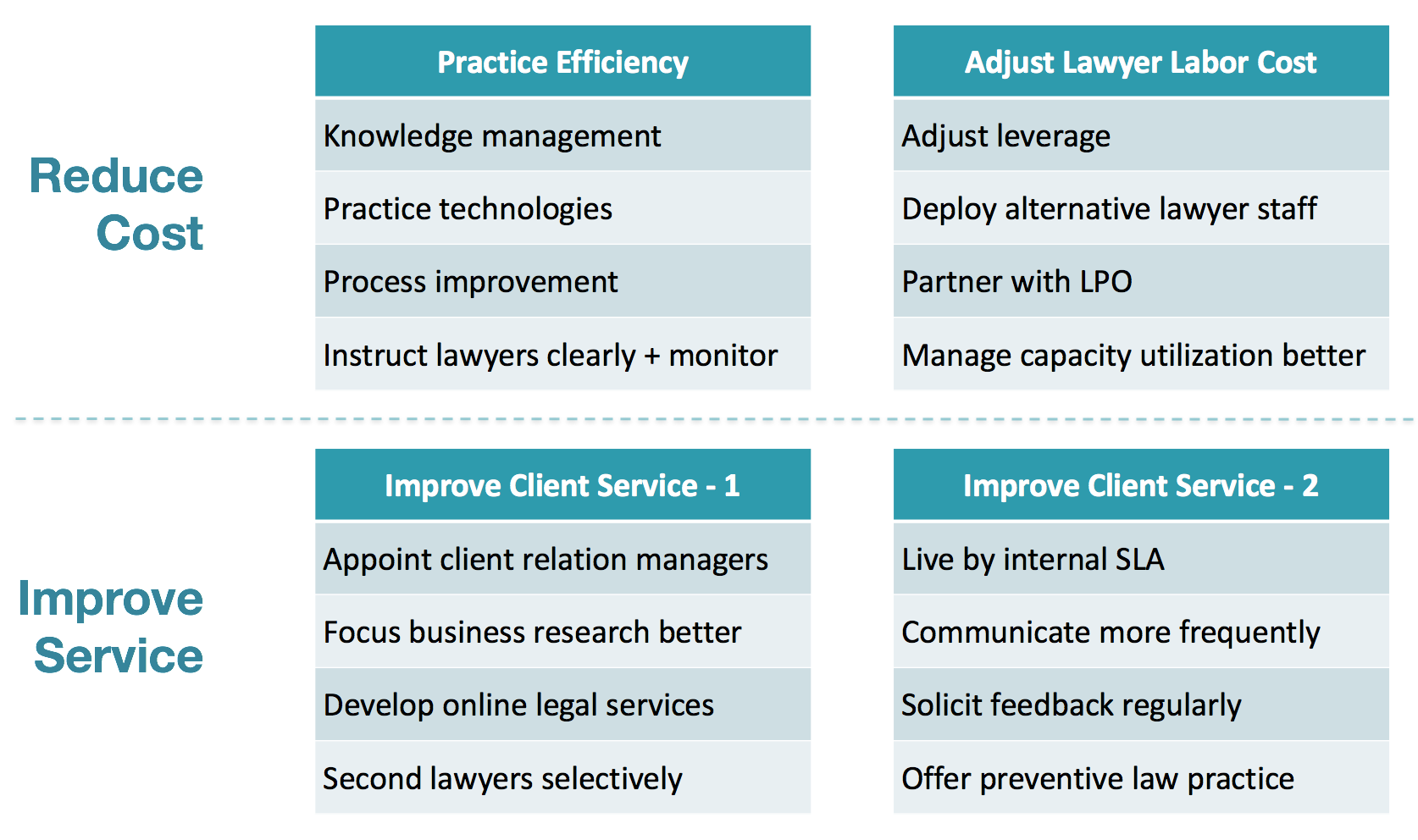Today, regular contributor Ron Friedmann, provides readers with a glass half-full tour de force on why Large Law Firms Must Improve Client Service Delivery. Ron examines the critical importance for clients and firms of differentiating one large law firm from another.
In the current ultra-competitive market for legal services, large law firms must improve client service delivery. I explain why in this post: the stratification of large law firms, the failure of traditional strategies, the lack of differentiation among most firms outside the top tier, and client dissatisfaction with law firm service.
The Stratification of Large Firms: A Top Tier and All the Rest
Winner takes all is a common story, including in the corporate legal market. Ten years after the economic crisis, legal market surveys tell the same story consistently: “Increasing stratification among firms” Choppy Seas for The Am Law 100, 1 May 2017, American Lawyer, also notes that the “country’s largest firms are still experiencing healthy growth in RPL while that figure is on the decline for their smaller competitors.” Revenue per lawyer is a key indicator of financial health. Many other studies come to a similar conclusion: an emerging top tier of some 20 firms with a big gulf from all the rest. What should firms not in the top tier do?
The Demise of Strategy?
Large law firms have long pursued mergers, lateral hires, and growth as key strategies to increase profitability. Do these work? Recent studies suggest not. The chart here summarizes key findings; survey findings follow:
Size Matters Not So Much, a guest post at Adam Smith, Esq. (aka Bruce McEwen) in March 2017 found that law firm size hardly correlates with profitability. “When an incumbent partner contemplates an investment in growth and asks ‘Will this put more money in my pocket?’ the answer cannot be supported by any broad statement about firm size among the American Lawyer Top 200”
The Untold Story Behind Big Law Mergers: Revenue Slips, Costs Rise in The American Lawyer in March, notes that an ALM Intelligence report found “that most major law firm combinations since 2000 have not resulted in significant growth.” Of course, mergers made the firms bigger. But growing bigger did not fuel any additional growth.
Global Lateral Hiring by The Numbers: A Look Behind the High 5-Year Attrition Rate in American Lawyer International in February found that “Half of lateral partner hires are failures. To be precise, 47 percent of laterals don’t stay more than 5 full years.” And not staying at least 5 years leads to losses it found.
So, for strategy, what does work? The Five Strategies of Highly Successful Firms by Bill Henderson in the American Lawyer in January 2017 found that five strategic strategies do work to boost profits:
- “Have a large and distinctive financial services practice”
- “Avoid lots of labor and employment lawyers (unless L&E is your focus)”
- “Embrace a headquarters model; concentrate lawyers geographically”
- “Bigger is not better, at least for profitability”
- “Focus. In the long run, less is more”
If a firm is not already doing these five things, getting there is not easy.
Of course, firms should not give up on strategy. Management must recognize, however, the firm’s current market position and have a realistic perspective on just how much traditional strategic initiatives can move its position.
So, what choices can management make?
The Answer for Most Firms? Differentiate with Service Delivery
Forty firms probably think they are in the top 20. Firms not in the top 20 must think about how they can differentiate from competitors. A few already have: some firms are value players, others are boutiques with specialized, high-end practices. But the bulk of firms look awfully similar.
Even if a firm comes up with one or more unique differentiators, it must improve service deliver to win and keep clients. Why is service delivery so key? BTI Consulting blogged in May CLOs to Law Firms: Fix Your Client Service or We’re Leaving. ” The client service opportunity is there for a primary law firm to lose. And lose they do” as the number of outside counsel decreases. The post continues
“Clients wonder why their top law firms don’t offer up a budget before being asked, share staffing plans, or offer to introduce new high‑profile laterals. Clients especially wonder why they weren’t offered a customized CLE session like their peer got from their law firm”.
As a result of what clients view as poor service levels, they recommend firms relatively infrequently:
With limited available strategic and differentiation moves and with clients complaining about service, it seems obvious that improving service delivery is the key. Yet the BTI findings suggest otherwise. So to do another set of recent findings…
Two key components of service delivery improve are better practice group management and robust legal project management. A recent study by Steve Nelson of The McCormick Group, published at 3 Geeks and a Law Blog, Midsize Firms Are Touting Efficiency, But They’re Not Hiring Efficiency Experts, found that firms outside the top tier invest less in these two areas than firms in the top tier. I took Steve’s tabular data created these charts:
These charts make clear that firms outside the top quartile are investing less in staff that could help them offer better service than top quartile firms.
Large firm service is not just an issue in the US. A survey released today by Thomson Reuters of UK GCs found that law firm responsiveness is the number one characteristic they look for. I Tweeted the survey Wednesday morning and by the evening had far more re-Tweets and likes than I usually get for a Tweet:
What’s more, the survey also found that “When it comes to responsiveness, countless interviewees gave examples of firms not acknowledging questions or even missing deadlines.” And, to add a legal tech angle to service delivery, here is another telling finding: “results show legal technology is now moving up the agenda for in-house counsel. Innovative service delivery through technology (rated 5.9 out of 10 in terms of importance) was ranked as a more important factor in choosing a law firm supplier than personal relationships between the firm and senior decision-makers (4.8)” [Emphasis added.]
What’s Next? Steps Firms Can Take to Differentiate and Improve Service Delivery
Law firms have many opportunities to improve service delivery. Practice group management and legal project management professionals are only two. Since this post is already long, I’ll end the post with a list of options firms can pursue that improve service delivery. I’ve organized them into client cost reduction and service improvement:
Conclusion
The sky stays in place, despite commentators predicting disruption and the demise of many law firms. Many firms seem to manage without making much change.
What I’ve described above is less a looming threat. Rather, it is a big opportunity. A glass half-full.







Excellent synthesis of the state-of-play for law firms, Ron. Glass may be half-full but that won’t last for long…..